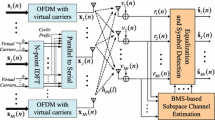Abstract
In this paper, we investigate the benefits of pre-processing received data by projection on the performance of channel estimation for orthogonal frequency division multiplexing (OFDM) systems. Projecting data onto its signal subspace will reduce the additive noise energy in the data. Least square (LS) estimation is a low-complex algorithm for training-based OFDM systems and the lower bound on the mean-square error of it is proportional to the noise variance. So, after the received data is pre-processed (projected onto its signal subspace), LS channel estimation on the pre-processed data will increase the performance of channel estimation. This method can also work in multiple-input and multiple-output (MIMO) case. Performance analysis and simulation results show that the proposed algorithm has a considerably smaller complexity than the linear minimum mean square error estimation while having almost the same performance.
Similar content being viewed by others
References
Barhumi I., Leus G., Moonen M. (2003). Optimal training design for MIMO OFDM systems in mobile wireless channels. IEEE Transactions on Signal Processing 51: 1615–1624
Li Y. (2002). Simplified channel estimation for OFDM systems with multiple transmit antennas. IEEE Transactions on Wireless Communications 1: 67–75
Morelli M., Mengali U. (2001). A comparison of pilot-aided channel estimation methods for OFDM systems. IEEE Transactions on Signal Processing 49: 3065–3073
Simeone O., Bar-Ness Y., Spagnolini U. (2004). Pilot-based channel estimation for OFDM systems by tracking the delay-subspace. IEEE Transactions on Wireless Communications 3: 315–325
Gong Y., Letaief K.B. (2003). Low complexity channel estimation for space-time coded wideband OFDM Systems. IEEE Transactions on Wireless Communications 2: 876–882
Edfors O., Sandell M., van de Beek J.-J., Wilson S.K., Bédb́aorjesson P.O. (1998). OFDM channel estimation by singular value decomposition. IEEE Transactions on communications 46: 931–939
Yang B. (1995). Projection approximation subspace tracking. IEEE Transactions on Signal Processing 43: 95–107
Patzold M. (2002). Mobile fading channels. West Sussex, England, John Wiley & Sons, Ltd
Alamouti S.M. (1998). A simple transmit diversity technique for wireless communications. IEEE Journal of Selected Areas on Communications 16: 1451–1458
Tarokh V., Jafarkhani H., Calderbank A.R. (1999). Space-Time block codes from orthogonal designs’. IEEE Transactions on Information Theory 45: 1456–1467
Author information
Authors and Affiliations
Corresponding author
Rights and permissions
About this article
Cite this article
Zhang, Y., Yin, Q. Subspace Projection-based OFDM Channel Estimation. Wireless Pers Commun 44, 371–381 (2008). https://doi.org/10.1007/s11277-007-9362-4
Received:
Accepted:
Published:
Issue Date:
DOI: https://doi.org/10.1007/s11277-007-9362-4




